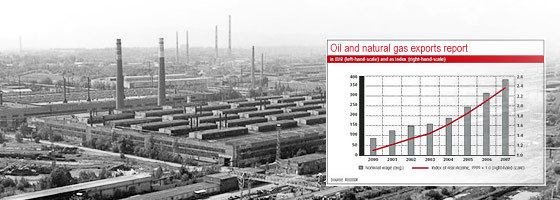Natural resources
The basis of the Russian economy is the extraction, processing and export of various types of mineral raw materials: oil and natural gas, coal, iron ore, apatites, potassium salts, phosphorites, diamonds, gold, silver, nickel, platinum, copper, etc.
Russia is one of the world leaders in production of oil (547.5 million tons in 2016) and natural gas (640.2 billion cubic meters in 2016). The total reserves of coal are more than 200 billion tons (more than 5% of world reserves). The main extraction is conducted at the Kuznetsk coal basin. In 2016, Russia produced 385.4 million tons of coal.
In Yakutia, there is the Elkon uranium deposit - the richest of the explored uranium deposits in Russia, one of the largest in the world. It accounts for more than half of the explored uranium reserves in the country - about 344 thousand tons.
The Russian company ALROSA is the world’s largest company in the exploration, production and sale of diamonds. In 2015, diamond mining in Russia amounted to 38.26 million carats. In 2016, Russia produced 288.55 tons of gold.
Russia accounts for about 3% of the world’s copper reserves. The Udokan deposit is one of the largest in the world. There are large reserves of copper in Norilsk.
News, notes and thoughts:
24 December, 2025 / In 2026, the per capita subsistence minimum in Russia will be 18,939 rubles (237 USD) per month (+6.8% compared to 2025), 20,644 - the working-age population, 16,288 - pensioners, 18,371 - children. Regions set their own subsistence minimums. It is the lowest total cost of food, goods, and services necessary for a person's life and health. In 2026, the minimum wage in Russia will be 27,093 rubles.
13 November, 2025 / In Jan-Oct 2025, according to preliminary data from the Ministry of Finance, the Russian federal budget revenues totaled 29,924B rubles (+0.8%), non-oil and gas revenues - 22,425B (+11.3%), oil and gas revenues - 7,498B (-21.4%), primarily due to a decline in the average oil price. Expenditures - 34,113B (+15.4%). The deficit - 4,189B. In 2025, the deficit is expected to be 2.6% of GDP.
28 October, 2025 / In 2026, the average state-funded pension in Russia (65+ years old - men, 60+ - women) will be about 28,000 rubles (350 USD) per month. The average social pension (does not depend on the length of employment and accumulated contributions) - about 17,000 rubles (210 USD). Social pensions are granted 5 years after reaching the general retirement age.
Agriculture and industry
Russia has about 10% of all arable lands in the world located mainly in the Central Volga region, the Northern Caucasus, the Urals and Western Siberia.
The country is a major exporter of agricultural products, the world leader in wheat exports. The main crops are cereals (119 million tons in 2016, 4th in the world), sugar beet (48 million tons, 1st in the world), sunflower (11 million tons, 2nd in the world), soybean (3 million tons), potatoes (31 million tons, 3rd in the world), vegetables (16 million tons).
The main types of livestock products produced in Russia are meat (beef - 1.6 million tons, pork - 3.1 million tons, poultry - 4.5 million tons), milk (30.8 million tons), eggs (42.6 billions), wool (56 thousand tons), honey (68 thousand tons).
The food industry is relatively well developed, oriented mainly to the domestic market. Other important sectors of the economy include the oil refining industry, metallurgical production, chemical production, engineering (defense industry, automotive, railway and agricultural machinery).
Russia is one of the world leaders in power generation. Electricity is produced at thermal, nuclear and hydroelectric power stations. Russia exports electricity in significant quantities, mainly to Finland, Lithuania, China, Mongolia.
Transport system, Internet, tourism
The transport system in Russia is one of the most extensive in the world, including more than 120,000 km of railways, 1 million km of roads, 230,000 km of main pipelines, 100,000 km of inland waterways.
The huge territory and severe climate predetermined the paramount importance for Russia of all-weather types of land transport - railway and pipeline. They account for the bulk of freight. Water transport plays a much smaller role in Russia due to the short navigation period.
Today’s Russia has one of the most developed in the world market of mobile communication. It is the largest country in Europe in terms of the number of Internet users. More than 40% of the population has broadband Internet access.
Russia occupies one of the leading places in the world in the field of international tourism. In total, there are more than 100 resorts: resorts on the Black Sea coast of the Caucasus (Sochi), a group of resorts of the Caucasian Mineral Waters. Other popular objects of international and domestic tourism are St. Petersburg and the surrounding area, Moscow, Kazan, the cities and towns of the Golden Ring of Russia, the Volga River (cruise routes), Lake Baikal, Kamchatka.
By 2016, a number of paradoxes have clearly become apparent in the Russian economy: the first - a lot of poor working people, the second - unemployed men aged 25-35 years engaged in housekeeping, the third - working pensioners, the fourth - extremely high mortality among men of working age.


